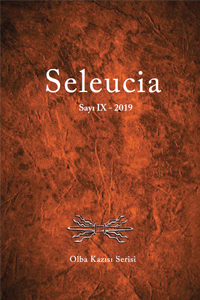Trabzon İmparatoru I. Manuel Komnenos 1238-1263 Dönemine Tarihlenen Balıkesir, Kuva-Yi Milliye Müzesi’ndeki Üç Adet Asper
Gümüş sikke, I. Manuel Komnenos, Trabzon İmparatorluğu, Kuva-yi Milliye Müzesi, Balıkesir
Trabzon İmparatoru I. Manuel Komnenos 1238-1263 Dönemine Tarihlenen Balıkesir, Kuva-Yi Milliye Müzesi’ndeki Üç Adet Asper
Silver coin, Manuel I Komnenos, Trebizond Empire, Kuva-yi Milliye Museum, Balıkesir,
___
- Bailly 2006 Bailly, A., Bizans İmparatorluğu Tarihi, İstanbul.
- Bateson - Campbell 1998 Bateson, J. D.-I. G. Campbell, Byzantine and Early Medieval Western European Coins in the Hunter Coin Cabinet, London. Foss 1991 Foss, C., “Trebizond”, ODB, Vol. 3, New York, 2112.
- Freeman & Sear 2007 Freeman&Sear, Mail Bid Sale 14, June 21, 2007, Los Angeles.
- Freeman & Sear 2009 Freeman&Sear, Mail Bid Sale 16, June 5, 2009, Los Angeles.
- Freeman & Sear 2010 Freeman&Sear, Manhattan Sale 1, January 5, 2010, Los Angeles. Gemini 2008 Gemini, Auction IV, Ancient and World Coins, January 8, 2008, New York. Grierson 1982 Grierson, P., Byzantine Coins, California. Grierson 1991 Grierson, P., “Asper”, ODB, Vol. 1, New York, 211. Haldon 2007 Haldon, J., Bizans Tarih Atlası, İstanbul. Hallman 2004 Hallman, R., “12N.Silver Asper of John II Komnenos of Treadgold 1997 Trebizond”, H.C. Evans (ed.) Byzantium Faith and Power (1261-1557), New York, 41.
- Helios Numismatik 2009 Helios Numismatik, Münzen and Antike Kunst, Auktion 4, (14 October, 2009), München.
- Helios Numismatik 2010 Helios Numismatik, Münzen and Antike Kunst, Auktion 4, (14 October, 2009), München.
- Helios Numismatik 2011 Helios Numismatik, Münzen and Antike Kunst, Auktion 4, (14 October, 2009), München. Hendy 1985 M. F. Hendy, Studies in the Byzantine Monetary Economy c.300-1450, New York. Hendy 1999 Hendy, M. F., Catalogue of the Byzantine Coins in the Dumbarton Oaks Collection and in the Whittemore Collection, Aleksius I to Michael VIII 1081-1261, Vol. Four, Part 1-2, Washington D.C.. Hendy 2008 Hendy, M. F., Studies in the Byzantine Monetary Economy c.300-1450, New York. Herrin 2010 Herrin, J., Bizans Bir Ortaçağ İmparatorluğunun Şaşırtıcı Yaşamı, İstanbul.
- Kazdhan - Cutler 1991 Kazdhan, A.-A. Cutler, “Manuel I. Komnenos”, ODB, Vol. 2, New York, 1290-1291.
- Kazdhan-Ševcenko 1991 Kazdhan, A.,-N. P. Ševčenko, “Eugenios”, ODB, Vol. 2, New York, 742-743. Kent 1985 Kent, J., A Selection of Byzantine Coins in the Barber Institute of Fine Arts, Birmingham.
- Levtchenko 1999 Levtchenko, M. V., Kuruluşundan Yıkılışına Kadar Bizans Tarihi, İstanbul. Lhotka 1989 Lhotka, J. F., Introduction to East Roman (Byzantine) Coinage, New York. Longuet 1961 Longuet, H., Introduction à la Numismatique Byzantine, London. ODB 1991 Talbot, A. M.-A. Kazdhan eds., The Oxford Dictionary of Byzantium, 3 Vols., New York. Reader 1987 Raeder, J., Die byzantinischen Münzen im Kestner- Museum Hannover, Hannover. Rattio 1959 Ratto, R., Monnaies Byzantine, Amsterdam. Retowski 1974 Retowski, O., Die Münzen der Komnenen von Trapezunt, Würzburg.
- Rosenquist 1996 Rosenqvist, J. O., The Hagiographic Dossier of St Eugenios of Trebizond in Codex Athous Dionysiou 154, Stockholm.
- Rosenquist 2002 Rosenqvist, J. O., “Local Worshippers, Imperial Patrons: Pilgrimage to St. Eugenios of Trebizond”, Dumbarton Oaks Papers, Vol. 56, Washington D.C., 193-212. Sabatier 1955 Sabatier, J., Description gènèrale des monnaies byzantines, Austria. Sayles 1998 Sayles, W. G., Ancient Coin Collecting V, The Romaion/ Byzantine Culture, Iola. Sear 2006 Sear, D., Byzantine Coins and Their Values, London. Talbot 1991 Talbot, A. M., “Panaretos, Michael” ODB, Vol. 3, New York, 1569-1570. Talbot 1991 Talbot, A. M., “Trebizond Empire Of” ODB, Vol. 3, New York, 2112-2113.
- ISSN: 2148-4120
- Başlangıç: 2011
- Yayıncı: Bilgin Kültür Sanat Yayınevi
Cecı N’est Pas Un Mur: Representatıon And Realıty In Ephesıan Urban Boundarıes
Manisa Müzesi Bizans Sikkeleri
Kızkalesi Kazılarında Ele Geçen 12. – 15. Yüzyıl Arasına Tarihlenen Orta Çağ Seramikleri
Archaoemetrıcal Perspectıves In Turkey
Olba Manastırı Hakkında Arkeolojik Ve Yazınsal Yeni Bilgiler
Mö II. - Ms IV. Yüzyıllar Arasında Cılıcıa’da Yahudiler
